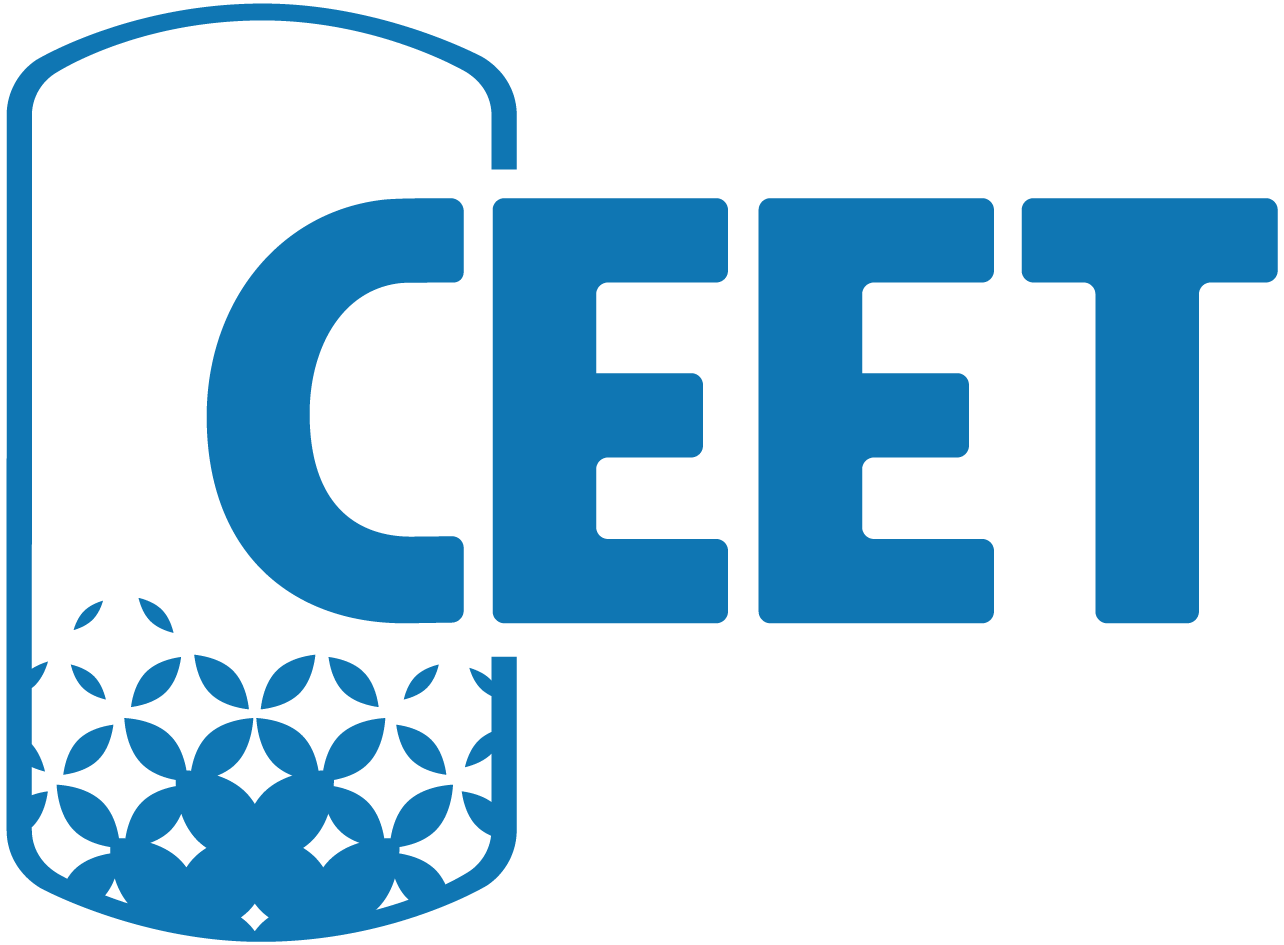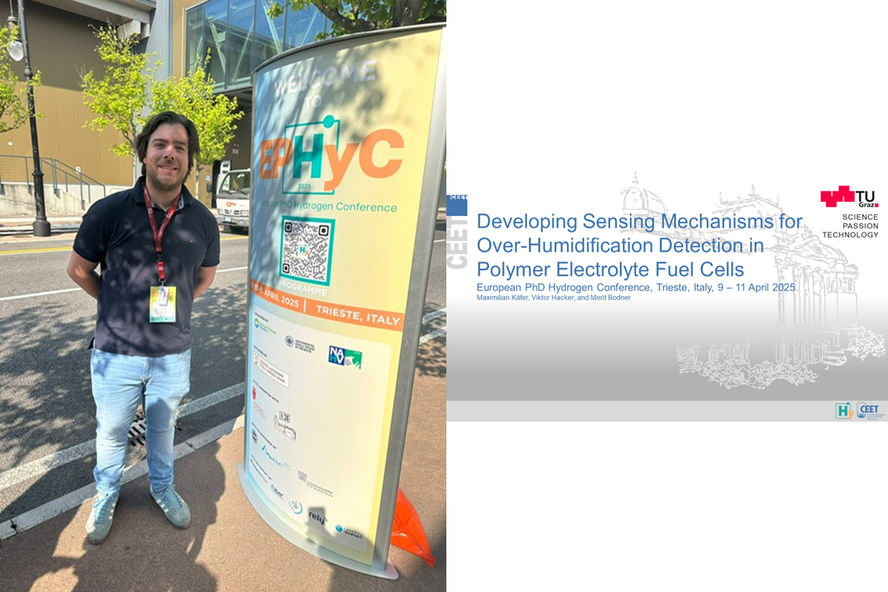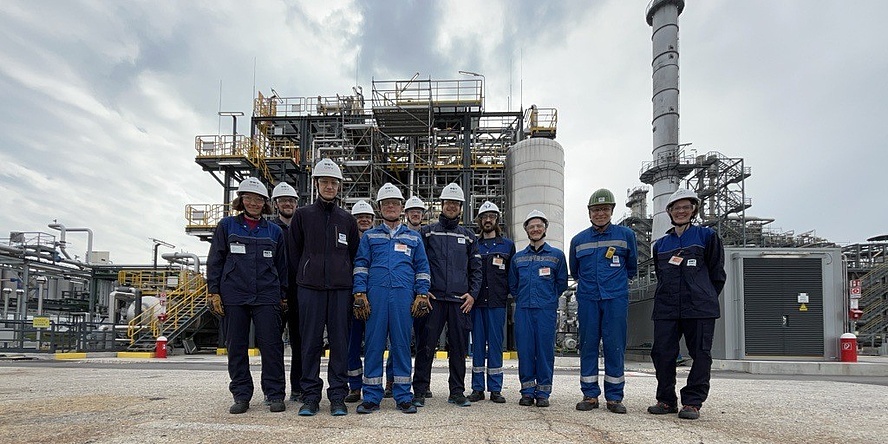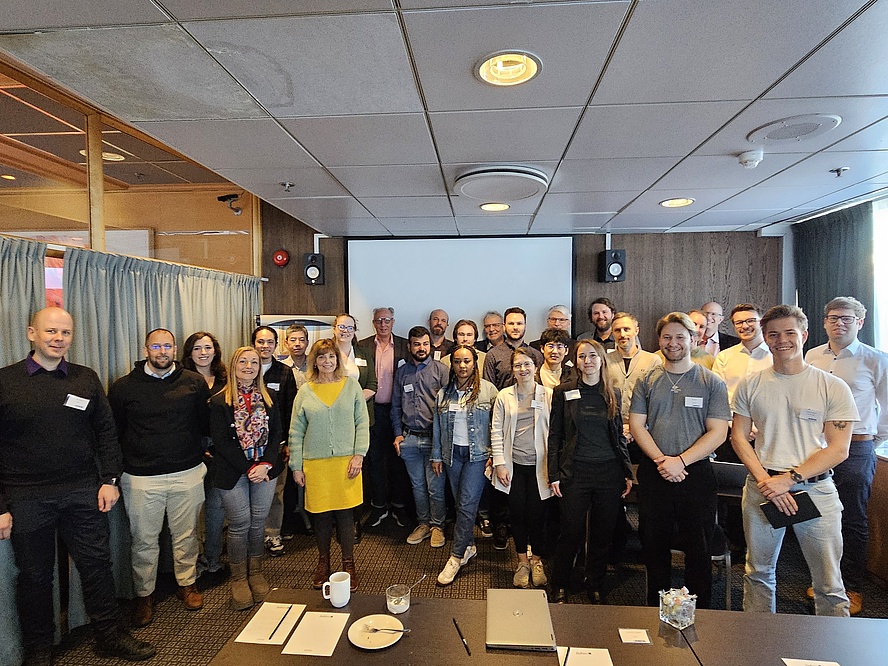Asep Samsudin and Viktor Hacker Development of Electrospun Quaternized Poly(vinyl alcohol)/Poly(acrylamide-co-diallyldimethylammonium chloride) Anion Exchange Membranes for Alkaline Fuel Cells
Publikation in PURE anzeigen
Clemens Wolf, Janine Maier, Julia Wenger, Georg Rudelstorfer, Christian Leypold, Julia Voglhuber-Höller, Matiss Reinfelds, Andrea Weiner, Arantza Muriana, Susanne Lux, Claudia Mair-Bauernfeind, Andreas Falk and Stefan Spirk Safe-and-sustainable-by-design redox active molecules for energy storage applications
Publikation in PURE anzeigen
Asep Samsudin, Nur Rokhati, Nor Basid Prasetya, Andri Cumoro, Didi Anggoro, Kharissa Nasher, Dhiky Wahyudi, Michaela Roschger and Viktor Hacker Impact of crosslinking on quaternary ammonium poly(vinyl alcohol)/polyquaternium-7 anion exchange membranes for alkaline polymer electrolyte fuel cells
Publikation in PURE anzeigen
R. Villablanca-Ahues, R. Nagl, T. Zeiner and P. Jaeger Aqueous-organic and aqueous-vapor interfacial phenomena for three phase systems containing CO2, CH4, n-butanol, n-dodecane and H2O at saturation conditions
Publikation in PURE anzeigen
Rafaela Greil, Jana Tomic and Susanne Lux Continuous separation of cobalt from sulphate solutions using saponified D2EHPA and Cyanex 272 in a Taylor-Couette Disc Contactor
Publikation in PURE anzeigen
Eveline Kuhnert, Kurt Mayer, Mathias Heidinger, Christine Rienessel, Viktor Hacker and Merit Bodner Impact of intermittent operation on photovoltaic-PEM electrolyzer systems: A degradation study based on accelerated stress testing
Publikation in PURE anzeigen
Max Vogi, Maximilian Neubauer, Susanne Lux and Thomas Wallek Triethylene Glycol as Entrainer for 1-Propanol + Water Mixtures
Publikation in PURE anzeigen
Paul Demmelmayer, Jia Wen Foo, Dominik Wiesler, Georg Rudelstorfer and Marlene Kienberger Reactive liquid-liquid extraction of lactic acid from microfiltered sweet sorghum silage press juice in an agitated extraction column using a hydrophobic natural deep eutectic solvent as modifier
Publikation in PURE anzeigen
Clemens Fink, Joel Mata Edjokola, Marijo Telenta and Merit Bodner Modeling of Catalyst Degradation in Polymer Electrolyte Membrane Fuel Cells Applied to Three-Dimensional Computational Fluid Dynamics Simulation
Publikation in PURE anzeigen
Alexander Kaufmann, Lars Häcker, Jacob Michael Mayer, Hansjörg Weber and Marlene Kienberger Characterization of Camphene- and Fenchol-Based Hydrophobic Eutectic Solvents and Their Application in Aldehyde Extraction
Publikation in PURE anzeigen
Sascha Kleiber, Andreas Böhm and Susanne Lux Effect of pressure on direct reduction of mineral iron carbonate with hydrogen
Publikation in PURE anzeigen
Florian Tritscher, Alexander Pranter, Fabio Blaschke, Werner Napetschnig, Maximilian Fuchs, Fabio Eduardo Machado Charry, Viktor Hacker and Merit Bodner Thermal stability and microstructure of fluorine-free hydrophobic coatings of gas diffusion layers for fuel cell applications
Publikation in PURE anzeigen
Muhammad Yusro and Viktor Hacker Fabricating ultra-thin nanofiber structures towards advanced MEA of fuel cell: Investigation of degree of alignment, diameter, bead generation, and precision with Taguchi design
Publikation in PURE anzeigen
Joel Mata Edjokola, Mathias Heidinger, Amir Niroumand, Viktor Hacker and Merit Bodner Chemical Oxidation-Induced Degradation in Gas Diffusion Layers for PEFC: Mechanisms and Performance Implications
Publikation in PURE anzeigen
Paul Demmelmayer, Marija Ćosić and Marlene Kienberger Mineral Acid Co-Extraction in Reactive Extraction of Lactic Acid Using a Thymol-Menthol Deep Eutectic Solvent as a Green Modifier
Publikation in PURE anzeigen
J. Deuerling, A. Alsalih, R. Nagl, T. Zeiner, J. U. Repke and M. Rädle Investigation of interfacial mass transfer phenomena applying non-invasive Raman imaging and density gradient theory
Publikation in PURE anzeigen
Lukas Fernando Roessler Escudero, Viktor Hacker and Merit Bodner Adjusting the operating boundaries for the mitigation of SO2 crossover in sulphur depolarized electrolysers
Publikation in PURE anzeigen
Fabio Blaschke, Prabhu Prasad Biswal, Fabio Eduardo Machado Charry, Katharina Halper, Maximilian Fuchs, Roland Resel, Karin Zojer, Michael Lammer, Richard Hasso and Viktor Hacker Advancing Green Hydrogen Purity with Iron-Based Self-Cleaning Oxygen Carriers in Chemical Looping Hydrogen
Publikation in PURE anzeigen
Nico Nys, Lorenz Buchgraber, Peter Neugebauer, Matthew J. Jones and Heidrun Gruber-Woelfler Design and Characterization of a Novel Continuous Annular Gap Crystallizer
Publikation in PURE anzeigen
Eveline Kuhnert, Mathias Heidinger, Anna Bernroitner, Özge Kiziltan, Erwin Berger, Viktor Hacker and Merit Bodner Fluoride emission rate analysis in proton exchange membrane water electrolyzer cells
Publikation in PURE anzeigen
Alexander Kaufmann, Lukas Maier and Marlene Kienberger Solvent screening for the extraction of aromatic aldehydes
Publikation in PURE anzeigen
Joel Mata Edjokola, Marco Bogar, Maximilian Grandi, Rodolfo Taccani, Heinz Amenitsch, Marjan Marinšek, Viktor Hacker and Merit Bodner Humidity-Induced Degradation Mapping of Pt3Co ORR Catalyst for PEFC by In-Operando Electrochemistry and Ex Situ SAXS.
Publikation in PURE anzeigen
R. Villablanca-Ahues, R. Nagl, T. Zeiner and P. Jaeger Interactions at the interfaces of the H2-brine-cement systems at elevated pressures for H2 storage
Publikation in PURE anzeigen
Rafaela Greil, Joevy Chai, Georg Rudelstorfer, Stefan Mitsche and Susanne Lux Water as a Sustainable Leaching Agent for the Selective Leaching of Lithium from Spent Lithium-Ion Batteries
Publikation in PURE anzeigen
Fabio Blaschke, Marjan Bele, Spela Polak, Brigitte Bitschnau and Viktor Hacker Core-shell iron-based oxygen carrier material for highly efficient green hydrogen production by chemical looping
Publikation in PURE anzeigen
Fabio Blaschke, Marjan Bele, Brigitte Bitschnau and Viktor Hacker Stabilizing effect of support materials on iron-based oxygen carrier pellets for chemical looping hydrogen in long-term operation
Publikation in PURE anzeigen
Thomas Steiner, Kai Schulze, Norbert Kienzl, Magdalena Pauritsch, Viktor Hacker, Sebastian Bock, Alberto Abad, Robert Scharler and Andrés Anca-Couce Chemical looping of synthetic ilmenite, Part I: Addressing challenges of kinetic TGA measurements with H2
Publikation in PURE anzeigen
Viktor Hacker and Merit Bodner Innovative chemische Speichermedien für erneuerbare Energien
Publikation in PURE anzeigen
Adrian Drescher, Lisa Schwingshackl and Marlene Kienberger Identification of molecules from tomato plant residues using sustainable green chemicals
Publikation in PURE anzeigen
Hafiz Farooq Imtiaz A Framework for Upscaling of Emerging Chemical Processes Based on Thermodynamic Process Modeling and Simulation
Publikation in PURE anzeigen
Muhammad Yusro and Viktor Hacker Fabricating ultra-thin nanofiber structures towards the advanced MEA of fuel cells
Publikation in PURE anzeigen
Anna Jodlbauer, Jonas Spychala, Katharina Hogrefe, Bernhard Gadermaier and H. Martin R. Wilkening Fast Li Ion Dynamics in Defect-Rich Nanocrystalline Li4PS4I─The Effect of Disorder on Activation Energies and Attempt Frequencies
Publikation in PURE anzeigen
Sebastian Soritz, Nico Nys, Matteo Thierrichter, Lorenz Buchgraber, Richard Amering, Peter Neugebauer and Heidrun Gruber-Woelfler Development of a 3D Printed Flow Cell for Application as an In-line Optical Particle Analysis Tool
Publikation in PURE anzeigen
Kamonrat Suksumrit, Christoph A. Hauzenberger, Srett Santitharangkun and Susanne Lux Reduced Siderite Ore Combined with Magnesium Oxide as Support Material for Ni-Based Catalysts; An Experimental Study on CO2 Methanation
Publikation in PURE anzeigen
Fabio Blaschke Spaziergang im Science Garden
Publikation in PURE anzeigen
Fabio Blaschke, Richard Hasso and Viktor Hacker Unlocking synergistic effects of mixed ionic electronic oxygen carriers in ceramic-structured environments for efficient green hydrogen storage
Publikation in PURE anzeigen
Mehr anzeigen...
Michaela Roschger, Sigrid Wolf, Kurt Mayer, Matthias Singer and Viktor Hacker Alkaline Direct Ethanol Fuel Cell: Effect of the Anode Flow Field Design and the Setup Parameters on Performance
Publikation in PURE anzeigen
Paul Demmelmayer and Marlene Kienberger Reactive extraction of lactic acid from sweet sorghum silage press juice
Publikation in PURE anzeigen
Zengxuan Fan, Tim Zeiner, Sabine Enders and Michael Fischlschweiger Thermodynamic Modeling of the Solid-Liquid Phase Transition in Polyethylene Copolymer-Solvent Systems Based on Continuous Thermodynamics and Lattice Cluster Theory
Publikation in PURE anzeigen
Ye Li Mo, Michael Fischlschweiger and Tim Zeiner Polymeric Aqueous Two Phase System with an Immobilized Phase by Cross-Linking
Publikation in PURE anzeigen
Asep Muhamad Samsudin, Michaela Roschger, Sigrid Wolf and Viktor Hacker Preparation and characterization of QPVA/PDDA Electrospun Nanofiber Anion Exchange Membranes for Alkaline Fuel Cells
Publikation in PURE anzeigen
Michaela Roschger, Sigrid Wolf, Bostjan Genorio and Viktor Hacker Effect of PdNiBi Metal Content: Cost Reduction in Alkaline Direct Ethanol Fuel Cells
Publikation in PURE anzeigen
Sigrid Wolf, Michaela Roschger, Boštjan Genorio, Daniel Garstenauer, Josip Radić and Viktor Hacker Ce-modified Co–Mn oxide spinel on reduced graphene oxide and carbon black as ethanol tolerant oxygen reduction electrocatalyst in alkaline media
Publikation in PURE anzeigen
Roland Nagl, Sandrina Stocker, Patrick Zimmermann and Tim Zeiner Study on mass transfer in reactive liquid-liquid systems
Publikation in PURE anzeigen
Georg Rudelstorfer, Maximilian Neubauer, Matthäus Siebenhofer, Susanne Lux and Annika Grafschafter Esterification of Acetic Acid with Methanol and Simultaneous Product Isolation by Liquid-Liquid Extraction in a Taylor-Couette Disc Contactor
Publikation in PURE anzeigen
Roland Nagl, Tim Zeiner and Patrick Zimmermann Interfacial Mass Transfer in Quaternary Liquid-Liquid Systems
Publikation in PURE anzeigen
Bernd Stoppacher, Thomas Sterniczky, Sebastian Bock and Viktor Hacker On-site production of high-purity hydrogen from raw biogas with fixed-bed chemical looping
Publikation in PURE anzeigen
Sigrid Wolf, Michaela Roschger, Bostjan Genorio, Mitja Kolar, Daniel Garstenauer, Brigitte Bitschnau and Viktor Hacker Ag-MnxOy on Graphene Oxide Derivatives as Oxygen Reduction Reaction Catalyst in Alkaline Direct Ethanol Fuel Cells
Publikation in PURE anzeigen
Astrid Loder, Simone Santner, Matthäus Siebenhofer, Andreas Böhm and Susanne Lux Reaction kinetics of direct reduction of mineral iron carbonate with hydrogen
Publikation in PURE anzeigen
Silvia Maitz, Matthäus Siebenhofer and Marlene Kienberger Conversion of carbohydrates to carboxylic acids during hydrothermal and oxidative treatment of concentrated kraft black liquor
Publikation in PURE anzeigen
Sebastian Bock, Magdalena Pauritsch, Susanne Lux and Viktor Hacker Natural iron ores for large-scale thermochemical hydrogen and energy storage
Publikation in PURE anzeigen
Susanne Lux Application of the TRIZ Contradictory Matrix to Foster Innovation for Sustainable Chemical Engineering
Publikation in PURE anzeigen
Sascha Kleiber, Astrid Loder, Matthäus Siebenhofer, Andreas Böhm and Susanne Lux Direct Reduction of Siderite Ore Combined with Catalytic CO/CO2 Hydrogenation to Methane and Methanol: A Technology Concept
Publikation in PURE anzeigen
Fabian Zapf and Thomas Wallek Case-study of a flowsheet simulation using deep-learning process models for multi-objective optimization of petrochemical production plants
Publikation in PURE anzeigen
Saeid Abrari, Vahid Daneshvariesfahlan, Mir Ghasem Hosseini, Raana Mahmoodi and Viktor Hacker Multi‑walled carbon nanotube‑supported Ni@Pd core–shell electrocatalyst for direct formate fuel cells
Publikation in PURE anzeigen
Mehr anzeigen...




